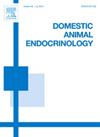Comparison of moderate (7% on dry matter basis) and high (15% on dry matter basis) fiber diets on glycemic control in dogs with spontaneous insulin deficient diabetes mellitus
IF 2.1
2区 农林科学
Q2 AGRICULTURE, DAIRY & ANIMAL SCIENCE
引用次数: 0
Abstract
The objective of the study was to compare the effects of a moderate fiber (MF, 7 % crude fiber on a dry matter basis, 1.9 g/100 kcal) versus a high fiber (HF, 15 % crude fiber on a dry matter basis, 4.4 g/100 kcal) diet on glycemic control in dogs with spontaneous insulin deficient diabetes mellitus. Eight adult dogs with stable spontaneous insulin deficient diabetes mellitus receiving intermediate-action insulin administered subcutaneously every 12 h completed the study. Dogs were fed MF and HF diets for 12 weeks in a crossover study design. Complete blood counts, serum biochemistry, urinalysis, 24-hour blood glucose curve, mean 24-hour blood glucose, and glycosylated hemoglobin (HbA1c) percent were evaluated throughout the study as used to compare the MF and HF diets against the individual dogs’ base diet. A significant difference was not observed in HbA1c percent and mean 24-hour blood glucose concentrations in dogs consuming either MF or HF diets. HbA1c percent and mean 24-hour blood glucose were significantly lower in dogs consuming these MF and HF diets compared to their individual base diets. Based on these data it would be recommended to provide a dog with spontaneous insulin deficient diabetes mellitus a diet containing at least 7 % crude fiber on a dry matter basis (1.9 g/100 kcal) in addition to their injectable insulin requirements to improve their glycemic control.

中纤维(干物质基础7%)和高纤维(干物质基础15%)饲粮对自发性胰岛素缺乏性糖尿病犬血糖控制的比较
该研究的目的是比较中等纤维(MF,干物质基础上的7%粗纤维,1.9 g/100 kcal)和高纤维(HF,干物质基础上的15%粗纤维,4.4 g/100 kcal)饮食对自发性胰岛素缺乏型糖尿病狗的血糖控制的影响。8只患有稳定自发性胰岛素缺乏性糖尿病的成年犬每12小时皮下注射一次中效胰岛素。在交叉研究设计中,狗被喂食MF和HF饮食12周。在整个研究过程中,对全血细胞计数、血清生化、尿液分析、24小时血糖曲线、平均24小时血糖和糖化血红蛋白(HbA1c)百分比进行评估,用于将MF和HF饮食与单个狗的基础饮食进行比较。在食用MF或HF饮食的狗中,HbA1c百分比和平均24小时血糖浓度没有显著差异。与个体基础饮食相比,食用这些MF和HF饮食的狗的HbA1c百分比和平均24小时血糖显著降低。基于这些数据,建议为自发性胰岛素缺乏性糖尿病犬提供至少含有7%干物质粗纤维(1.9 g/100 kcal)的日粮,以改善其血糖控制。
本文章由计算机程序翻译,如有差异,请以英文原文为准。
求助全文
约1分钟内获得全文
求助全文
来源期刊

Domestic animal endocrinology
农林科学-奶制品与动物科学
CiteScore
5.50
自引率
4.80%
发文量
58
审稿时长
31 days
期刊介绍:
Domestic Animal Endocrinology publishes scientific papers dealing with the study of the endocrine physiology of domestic animal species. Those manuscripts utilizing other species as models for clinical or production problems associated with domestic animals are also welcome.
Topics covered include:
Classical and reproductive endocrinology-
Clinical and applied endocrinology-
Regulation of hormone secretion-
Hormone action-
Molecular biology-
Cytokines-
Growth factors
 求助内容:
求助内容: 应助结果提醒方式:
应助结果提醒方式:


